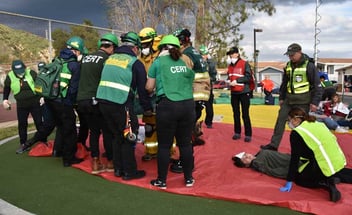Free Disaster Response Toolkit
Disasters strike in every corner of the world, during every season, and on different scales throughout the year. Nonprofit organizations serve as key players during these disasters, providing aid and resources to those affected. Hospitals, food banks, human and animal shelters, and other nonprofits are integrated into most response and recovery efforts during emergencies.
These events are often unexpected by their very nature, leaving little time to mobilize your volunteers. Yet the benefits of emergency preparedness and disaster preparedness are clear: saved lives and faster recovery. That’s why it is so important to put time into planning and preparation long before disaster strikes.
We spoke with Cameron Waldner, CEO of Volunteer Houston, about the importance of preparedness for disasters. His organization has been part of the response and recovery effort following the devastating effects of Hurricane Harvey. In this disaster preparedness article, we’ve included information on preparing for a disaster, as well as Waldner’s advice to nonprofits that find themselves in the midst of disaster response.
What is disaster preparedness?
Disaster awareness and preparedness refers to the preventive measures taken to reduce the severity of a disaster’s effects. The goal of disaster and emergency preparedness is to lessen the impact of disasters on vulnerable populations, to ready an organization for an influx of activity, and to design a coordinated plan that reduces the waste of resources, time, and effort. Preparedness for disasters seeks to save the maximum number of lives and property during a disaster, and it aims to return the affected populations to normalcy as quickly as possible.
Nonprofits and volunteer organizations must prepare for prompt recovery efforts, and should therefore compose a nonprofit emergency plan or disaster response plan to better assist professionals and governments.
How do volunteer organizations play a role in disaster recovery?
Collaborating agencies responding to disasters include local governments, emergency managers, and other nonprofit organizations to support emergency and disaster response efforts. According to Waldner, “the primary goal is to be the conduit between multiple organizations, and to be able to sit at the table with Voluntary Organizations Active in Disaster, or VOADs. Being a part of your local and regional VOAD is imperative, and if not it greatly hinders everything else.”
It is essential to cultivate these kinds of relationships in a pre-disaster environment. The chaotic and deadly aftermath of Hurricane Katrina serves as a reminder of the importance of cross-sector coordination and collaboration. Organizations can learn from the mistakes made in past disasters and improve the strength of communication to better prepare for the next emergency or disaster situation.
Preparing for disasters: disaster planning for volunteer organizations
When does disaster management begin? As soon as possible! All nonprofit organizations should create thorough documentation that briefs staff and volunteers in the event of disaster– before disaster strikes. Though it may seem difficult or time-consuming to plan for the unexpected, preparing for disaster is a necessary practice for future events. The following list is by no means exhaustive, but it includes important considerations for disaster planning.
Develop a continuity of operations plan
A continuity of operations plan for nonprofits (also referred to as a business continuity plan) is defined as “the comprehensive process of planning for, and retooling, the organization’s best practices so that the nonprofit can function successfully after the crisis has passed, getting back quickly to where it was before the interruption.” Continuity planning outlines what actions a nonprofit will take before disaster strikes, the immediate steps to follow after the interruption of service, and the disaster recovery plan for nonprofit organizations (which details necessary actions for restoring functionality).
The Emergency Network of Los Angeles (ENLA) created a comprehensive business continuity plan template for nonprofits, which you can access here. Having a well-crafted business continuity plan will help ensure limited disruption of services, so that your organization can most effectively assist in recovery efforts. The business continuity plan is an essential component of the larger disaster preparedness nonprofit plan.
Define your nonprofit’s purpose, priorities, and principles
When you write your nonprofit emergency management plan, begin with an explanation of why a disaster plan is relevant to your organization, the people you serve, and your mission. This succinct explanation will help you and your organization understand where they fit into the disaster response and recovery efforts later on.
Have disaster web-content ready to go
When asked to give advice to other nonprofits based on his experience with Hurricane Harvey, Waldner suggested that you should “manage your messaging.” He explained, “we had some of our folks working on messaging, and also getting everything standardized,” stating that “that was the big piece.” He recommended that you “have all of your graphics ready to go for a disaster” in order to “plug and place as needed.” For instance, he explained how he knew what dimensions he needed for his organization’s home page and his Get Connected volunteer site banner ahead of time. He had also planned content for his organization’s Twitter and Facebook accounts. Having this information ready will save time later on by eliminating the need to create materials from remote locations– especially if your office is affected by disaster.
Prepare your website
In Waldner’s case, it was vital that his disaster management website was ready to go before responding to the disaster in Houston. When asked for advice on how to prepare one’s website, he said “be flexible and mindful of your user environment on your website. We were able to move our website into disaster mode. We also had to buy additional bandwidth from GoDaddy in the midst of it, and that was already having some precautions set up.” Because of these changes, he said, “we were able to get our website up and going, and in that we were able to manage the influx of volunteers—we had over 60,000 people register in eight days.”
The addition of a volunteer management software or disaster management software will help you efficiently connect volunteers with service opportunities.
Waldner said that one of his best methods for organizing an influx of volunteers was “trying to get ahead of the news and also utilizing the [disaster management] website.” He explained that “before we took over managing the George R. Brown Convention Center, there was a line of volunteers around the building that would take them anywhere from two to three hours just to get in to volunteer. By getting ahead of the messaging and working on it,” he said, “we were able to schedule volunteer shifts and get that back under control.
Have a disaster preparedness plan for volunteers
There are two categories of disaster volunteers: affiliated volunteers and spontaneous unaffiliated volunteers. Affiliated volunteers work with specific agencies and have been trained in disaster-response techniques. Because they have training and are known to the agencies, they usually require little supervision. Spontaneous unaffiliated volunteers (SUVs), on the other hand, are citizens who want to help in the aftermath of the disaster. Despite their best intentions, SUVs can be hard to manage if you do not have a plan for doing so in place. As Waldner mentioned, he had over 60,000 people register to volunteer in only eight days! It is therefore crucial to have a plan in place for how to manage the large number of volunteers that respond in the aftermath of a disaster.
What is a disaster plan for volunteers?
Having a disaster plan for volunteers (some organizations may refer to a “nonprofit emergency management plan” or “natural disaster preparedness plan” ) allows you to better activate and deploy your volunteer force. Generally, you will work to place volunteers with other community organizations, so it’s important that your communications with these organizations and the relevant training is in place. You’ll want to develop a plan so you know the best ways to use and work with volunteers in a disaster. Your plan should include details about how you will recruit, task, and manage volunteers in preparation for an emergency or disaster. A disaster management software like ReDI by Galaxy Digital can help you recruit, manage, and communicate with disaster volunteers separately from your day-to-day volunteer pool (this is important to the process deploying the right volunteers efficiently). You can use the following disaster plan template for nonprofits and volunteer organizations to help you better prepare for disasters:
- Are your current volunteers appropriate for disaster related work?
- Do your current practices of recruiting or accepting volunteers include your disaster and emergency preparedness and response needs?
- What important activities (that keep your agency able to provide services) can be assigned to spontaneous volunteers? What activities should not be assigned to spontaneous volunteers?
- What safety and/or legal considerations should you include in your plan?
- Do you have insurance for volunteers?
- Do you have a background check system in place for volunteers?
- Is there any specialized training or knowledge required for working with your agency or other community-based agencies?
- Which staff members will manage volunteers before disaster strikes? Which staff members will manage volunteers immediately following an emergency or disaster? Are these staff properly trained in disaster response?
The questions presented in this disaster plan template for nonprofits and volunteer organizations should inform a document, or plan, that outlines key disaster and emergency volunteer procedures. Make sure all relevant staff members and emergency and disaster response volunteers have a copy of this plan. You can also download our Disaster Plan Development Checklist to assist Volunteer Coordinators with disaster planning.
When any disaster strikes, whether it be a hurricane, flood, domestic terrorism, tornado, or fire, the situation has the potential to create chaos and confusion. As a service-focused organization, being prepared for disaster helps alleviate some of the chaos wrought by the unexpected crisis. It is critical to have a written plan in place, and for all staff to understand their role within the plan. Disaster plans should be revisited regularly to ensure complete understanding within the organization. If you follow your disaster plan, it is possible for your nonprofit to get back up and running quickly and begin serving the populations affected by the disaster.
A big thank you to Cameron Waldner, CEO of Volunteer Houston, for his contributions to this article. We hope his insights and advice will help other nonprofits before they find themselves in the midst of disaster response.





